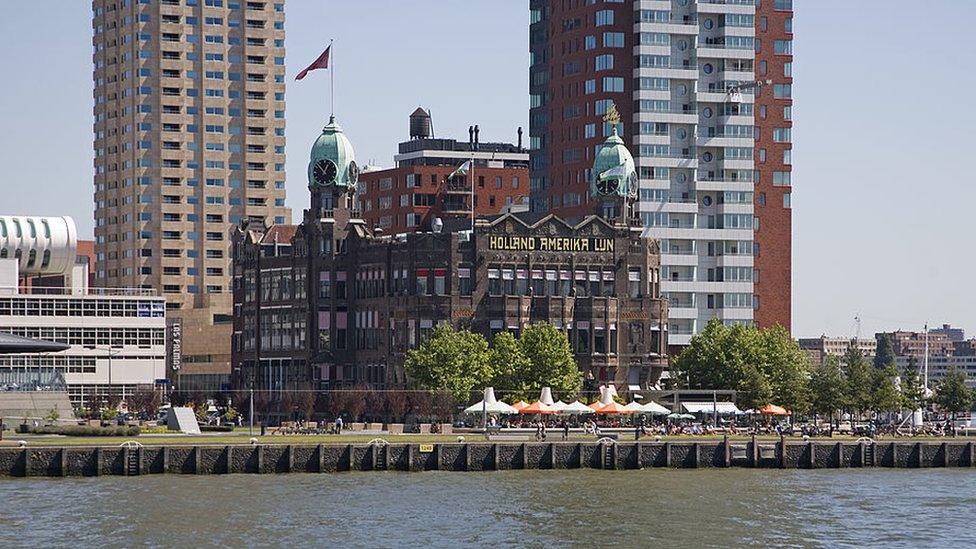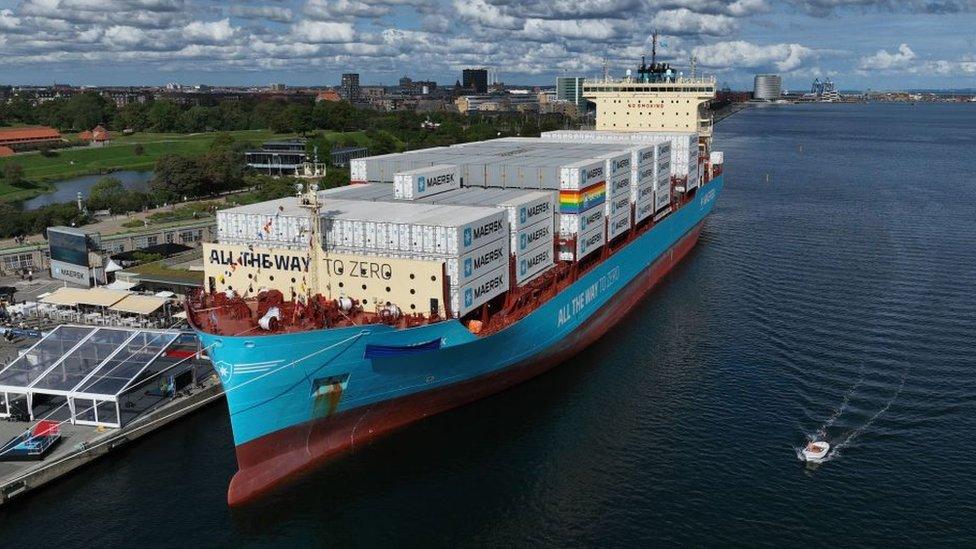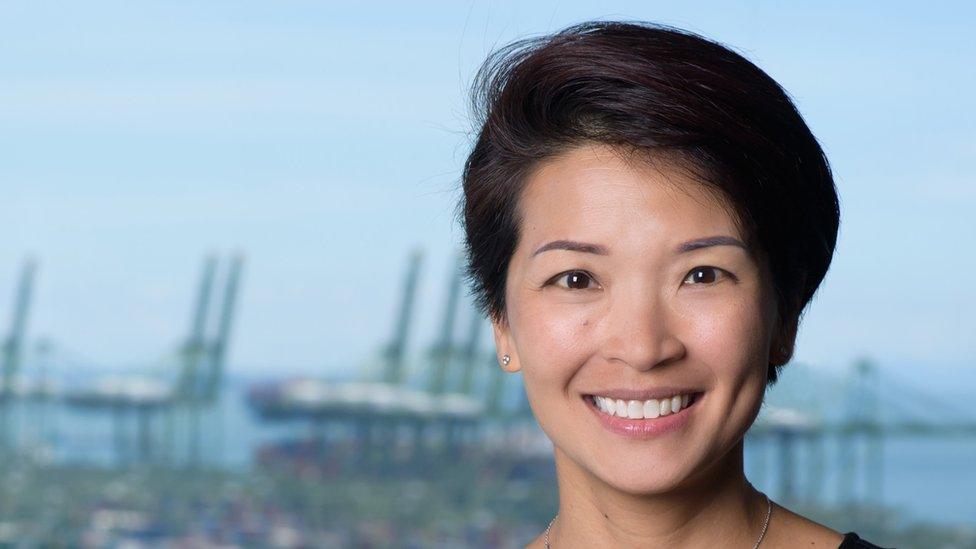Green shipping corridors gaining momentum
- Published

Rotterdam's historic Hotel New York building was formerly the headquarters of Dutch shipping firm Holland America Line
The powerful diesel engine roars as the water taxi cuts through the choppy water that connects Rotterdam's gritty port areas to what remains of the city's historic maritime grandeur.
As the yellow speedboat docks in front of the glamorous Hotel New York, the city's global shipping heritage is there for all to see.
The 122-year-old building, one of few to survive the extensive bombing of Rotterdam in World War Two, was originally the headquarters of Dutch shipping company Holland America Line. The firm's name is still adorned on the front of the building in large letters.
Next door, from its headquarters in a skyscraper that vaguely resembles a lighthouse, the Port of Rotterdam Authority is keen to shine a light on the future of shipping rather than look back on its past. More specifically, it is focusing its spotlight on how the sector can continue efforts to reduce it emissions.
As the manager and operator of Europe's largest port, the authority has partnered with its opposite number in Singapore to create one of the world's first new, long-distance green shipping corridors.
The idea behind these corridors is that cargo ships travel along the routes using only zero or low emission fuels. To help make this possible, both Rotterdam and Singapore are building new storage facilities for green fuels, such as ammonia and methanol, as alternatives to fuel oil.
Ammonia is a gas produced by fusing hydrogen with nitrogen. It is called "green ammonia" if the hydrogen is produced using 100% renewable energy. Meanwhile, methanol is a form of alcohol that can also be produced with green energy.
The Port of Rotterdam's interim chief executive, Boudewijn Siemons, says the link-up between the Dutch city and Singapore aims to show how the concept can practically work.
"It's a pragmatic approach to carbon reduction in shipping," he says. "We have to get started somewhere, and you cannot get started by implementing zero emission shipping as a total solution everywhere in the world.
"That's why we're seeking these green corridors as proof points on a limited scale. We then have to scale up from there."
In September of this year, the first container ship sailed between Singapore and Rotterdam in this green way. Called the Laura Maersk, it was powered by methanol, which currently delivers an up to 65% reduction, external in greenhouse gas emissions compared to burning fossil fuels.

The Laura Maersk went from Asia to Europe in September, powered by methanol
The green corridors concept was born at COP26, external, the global environment summit held in Glasgow, Scotland in 2021. Called the Clydebank Declaration, external, and agreed by 22 countries including the UK, it included a commitment to create at least six corridors by the middle of this decade.
This month's COP28 in the United Arab Emirates saw the announcement of new corridors, including one from Canada's west coast to Korea and Japan, one in the Caribbean, and another between Houston in the US and Belgium's Antwerp.
It followed a pledge by the International Maritime Organisation, which represents the shipping industry, that the sector will achieve net-zero emissions "by or around" 2050., external
While ports such as Rotterdam are continuing to prepare for the switch to zero emission shipping, it is clear that ship builders face an equally big challenge.
Industry figures show that just 0.6% of cargo ships around the world run on alternative fuels, and only 15 to 16% of vessels currently on order will run on dual or alternative fuels.
Yet there is some high-profile demand for more green shipping, such as from online shopping giant Amazon. The firm, a founding member of the Zero-Emission Maritime Buyers Alliance, along with other companies such as furniture group Ikea and clothing firm Patagonia, recently renewed, external a reduced emissions contract with shipping giant Maersk.
Meanwhile, cargo firm North Sea Container Line is launching a ship powered by ammonia,, external which will operate between Norway and Germany. And Hoegh Autoliners, which specialises in transporting cars and trains, is building 12 new ammonia-ready ships.
Lynn Loo is the chief executive of the Global Centre for Maritime Decarbonisation, a body that promotes the move to green fuels in the industry. She forecasts that ammonia production could double or even treble by 2050.
Ms Loo says there needs to be "a dramatic rise in the number of vessels capable of transporting ammonia from the 200 that are on the water today". She adds that there also needs to be "significant infrastructure buildout to support the much higher throughput of ammonia in the future".

Lynn Loo is predicting a big rise in the number of ships powered by ammonia
"None of these are going to be easy to scale," observes Edward Glossop, head of sustainable operations at Bunker Holding, the world's largest supplier of marine fuels.
"But ammonia may be the least challenging. The first ammonia engines will be delivered to shipyards by the end of 2024, and we aim to be a commercial supplier of low emission ammonia within the next few years."
However, there are currently no plans to enforce green shipping lanes and some who watch the industry doubt whether they will prove popular.
"We know the future fuels will be expensive," says veteran maritime economist Martin Stopford. "You're attempting to implement change that'll make people poorer, so it'll be unpopular."
He adds that even if production of clean fuels does take off, the maritime industry will be up against sectors such as manufacturing, domestic heating, road transportation aviation all competing for supplies.
"There is going to be some very big heavyweights in the queue ahead of shipping," says Mr Stopford.


New Tech Economy is a series exploring how technological innovation is set to shape the new emerging economic landscape.

Mr Siemons acknowledges that the process of decarbonising shipping "is both complex and expensive".
"But we should not predict the future based on the state of the technologies today, and on the state of the markets today," he reasons.
"Yes today fuel oil is cheaper than hydrogen or ammonia, but that doesn't mean it has to be so in the future."
Out on the water in front of his building, even Rotterdam's yellow water taxis are joining in the green transition. As far back as 2016, Europe's first electric-powered water taxi entered service here, and last year a hydrogen-powered one also took to the water.
"It all has to become renewable," Mr Siemons concludes.